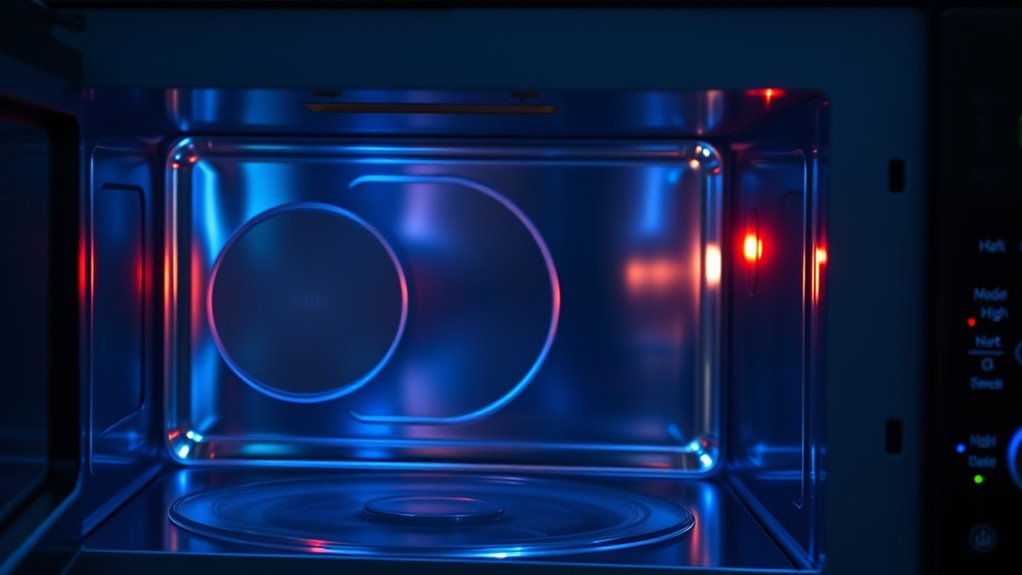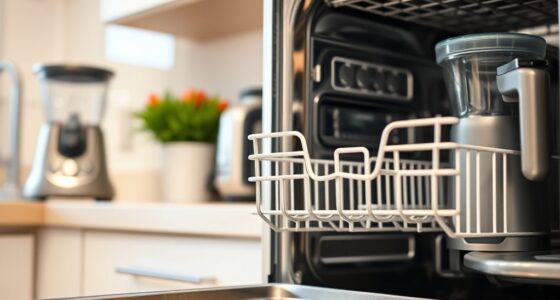To avoid overcooking or uneven heating, stop nuking everything on “high” and learn to adjust your microwave’s power levels. Using lower settings helps prevent hot spots, splatters, and food spoilage, making your meals safer and more evenly heated. It’s especially helpful when melting chocolate, defrosting meat, or reheating leftovers. Mastering power control can improve your cooking results and keep things safer—stick around to discover how to use different levels effectively.
Key Takeaways
- Using lower power levels ensures even heating and prevents hot spots, reducing the risk of overcooking or burning food.
- Adjusting power settings helps avoid splatters and spills inside the microwave, keeping it cleaner and safer.
- Lower power is ideal for delicate tasks like melting chocolate or softening butter without overdoing it.
- Defrosting at reduced power prevents uneven thawing and bacterial growth, ensuring food safety.
- Properly using different power levels enhances cooking control, improving food quality and prolonging microwave lifespan.

Microwave power levels determine how quickly and intensely your microwave heats food, giving you control over the cooking process. Instead of defaulting to the “high” setting for everything, understanding how to adjust power levels can improve your microwave safety and cooking techniques. When you use lower power settings, you prevent uneven heating, which helps avoid hot spots that might cause burns or food contamination. This control is especially important for delicate foods like melting chocolate, softening butter, or reheating leftovers evenly. Knowing when to turn down the power also reduces the risk of splatters and spills, keeping your microwave cleaner and safer.
Using different microwave power levels allows you to tailor your cooking techniques effectively. For example, when steaming vegetables or defrosting meat, a lower power helps prevent overcooking or partial thawing, which can lead to bacterial growth. Instead of rushing through the process on high, you give the heat time to penetrate evenly, resulting in better texture and flavor. This technique is particularly useful when reheating leftovers, as high power can cause food to dry out or become rubbery, while lower settings gently warm the meal without overdoing it. By adjusting power levels, you also gain more precision, which makes your microwave more versatile and saves you time and effort in the kitchen. Additionally, incorporating home security principles such as controlled access and monitoring can help safeguard your kitchen appliances and prevent accidents or misuse.
Frequently Asked Questions
Do Different Microwave Brands Have Varying Power Level Settings?
Yes, different microwave brands can have varying power level settings, which affects how they cook food. You might notice some brands offer more precise or broader power level options, leading to brand consistency issues. These power level variations mean you can’t always assume a microwave will operate the same way across brands. It’s a good idea to examine your microwave’s manual or test its power levels to guarantee you’re cooking effectively and not just relying on “high.”
Can Using Lower Power Levels Save Energy?
Yes, using lower power levels can save energy because it reduces overall power consumption during cooking. When you dial down the power, your microwave uses less energy, making it more energy efficient. This also prevents overcooking and helps preserve food quality. By choosing lower settings for tasks like reheating or simmering, you’re actively reducing energy waste, which benefits both your electricity bill and the environment.
How Do Power Levels Affect Cooking Time and Food Quality?
Adjusting the power level affects both cooking time and food quality. When you lower the power level, your microwave runs more efficiently, preventing overcooking and preserving food texture. It might take a bit longer to cook, but the result is better flavor and consistency. Power level adjustment helps you control how evenly food heats, ensuring you don’t end up with cold spots or burnt edges, ultimately improving microwave efficiency.
Are There Specific Foods Better Suited for Low or High Power?
Think of your microwave like a musical instrument—different foods need different settings to hit the right note. For delicate items like eggs or melting chocolate, low power guarantees gentle, safe heating, respecting microwave safety and culinary techniques. Denser foods like baked potatoes or stews benefit from high power to cook thoroughly without overcooking edges. Adjust power levels based on the dish to achieve even, safe, and delicious results every time.
What Happens if I Microwave on “High” for Too Long?
If you microwave on “high” for too long, you risk overcooking or burning your food, which can compromise microwave safety and reduce cooking precision. Overheating may cause spills, splatters, or even fires, especially if the food contains fats or sugars. To keep your microwave safe and make certain your food is cooked just right, use appropriate power levels and monitor the time carefully. This approach helps you achieve better results and avoids accidents.
Conclusion
So, next time you’re tempted to blast everything on “high,” remember it’s not just about speed—it’s about actually tasting your food. Ironically, those quick nukes often leave your meal uneven or rubbery, turning your effort into a microwave mess. Instead, try dialing down the power. You might just discover that patience pays off, and your leftovers aren’t just heated—they’re actually enjoyable. Who knew? Sometimes, slow and steady really does win the microwave race.









